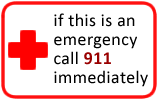Rash or Redness - Localized And Cause Unknown
Rash or Redness - Localized And Cause Unknown
Does this describe your child's symptoms? |
Click image for more info |
Definition
Causes
Localized Versus Widespread Rash: How to Decide
Return to School
|
If not, see these topicsFor an itchy rash:
For a non-itchy rash:
|
When to Call Your Doctor |
Call 911 Now (your child may need an ambulance) If |
|
|
|
Call Your Doctor Now (night or day) If |
|
|
|
Call Your Doctor Within 24 Hours (between 9 am and 4 pm) If |
|
|
|
Call Your Doctor During Weekday Office Hours If |
|
|
|
Parent Care at Home If |
|
|
HOME CARE ADVICE FOR LOCALIZED RASHES |
Reassurance: New localized rashes are usually due to skin contact with an irritating substance.
Avoid the Cause:
Try to find the cause.
Consider irritants like a plant (e.g., poison ivy), chemicals (e.g., solvents or insecticides), fiberglass, detergents, a new cosmetic, or new jewelry (e.g., nickel).
A pet may be the intermediary (e.g., with poison ivy or oak) or your child may react directly to pet saliva.
Avoid Soap: Wash the area once thoroughly with soap to remove any remaining irritants. Thereafter avoid soaps to this area. Cleanse the area when needed with warm water.
Local Cold: Apply a cold wet washcloth or soak in cold water for 20 minutes every 3 to 4 hours to reduce itching or pain.
Steroid Cream: If the itch is more than mild, apply 1% hydrocortisone cream (no prescription needed) 4 times per day. (EXCEPTION: suspected ringworm)
Avoid Scratching: Encourage your child not to scratch. Cut the fingernails short.
Contagiousness: Children with localized rashes do not need to miss any child care or school.
Expected Course: Most of these rashes pass in 2 to 3 days.
Call Your Doctor If:
Rash spreads or becomes worse
Rash lasts over 1 week
Your child becomes worse
And remember, contact your doctor if your child develops any of the "Call Your Doctor" symptoms.
Updated:
March 22, 2017







